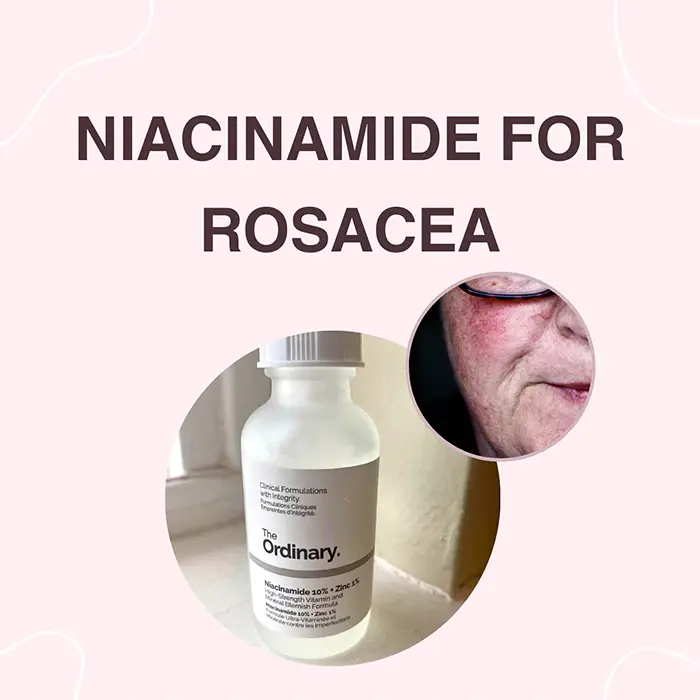
Rosacea-prone skin is usually very sensitive and prone to inflammation and redness. This means finding the best skincare products can be very hard, as your skin is likely to react to many cosmetic ingredients. However, actives like niacinamide (a form of vitamin B3) can help you manage your rosacea flare-ups efficiently. In this article, we will dive into how niacinamide can help manage rosacea, and provide some practical tips on how to incorporate this ingredient into your skincare routine.
Is Niacinamide Safe for Those with Rosacea?
Yes, niacinamide is generally considered safe for people with rosacea. It is known to have anti-inflammatory properties that can calm and soothe the skin. In fact, a study published in the Journal of Clinical and Aesthetic Dermatology found that a moisturizer containing niacinamide was well-tolerated and effective in improving the symptoms of rosacea.
However, while niacinamide is suitable for most people with rosacea, everyone’s skin is different. Some individuals may experience mild itching, redness, or irritation, particularly if they use high concentrations of niacinamide or if their skin is not accustomed to the ingredient. It’s always a good idea to perform a patch test before using a new product extensively.
Benefits of Niacinamide for Rosacea
Managing rosacea involves addressing a variety of skin issues such as redness, sensitivity, and occasional breakouts. In this context, niacinamide, a form of vitamin B3, stands out as an effective ingredient.
Niacinamide, has a range of benefits for the skin, including anti-inflammatory properties, barrier repair, decreased oil production, and hydration. Let’s take a closer look at how each of these can help manage rosacea symptoms.
Anti-Inflammatory Properties
Niacinamide has been shown to have an anti-inflammatory effect, which can help to reduce the redness and swelling associated with rosacea. A study in the Journal of Investigative Dermatology found that niacinamide reduced inflammation in human skin cells, providing evidence for its potential as a treatment for inflammatory skin conditions like rosacea.
Barrier Repair
The skin’s barrier function is often compromised in people with rosacea, leading to increased sensitivity and irritation. Niacinamide can help to strengthen the skin’s barrier, reducing sensitivity and improving the overall health of the skin.
Niacinamide works by boosting the skin’s production of important proteins such as keratin, which strengthens the skin. It also increases ceramides, which are fats that help keep the skin moist and firm. These actions are vital for repairing and maintaining a healthy skin barrier.
Additionally, niacinamide helps skin cells mature more effectively and increases the amount of NADP, a molecule that plays a key role in many skin cell functions.
Decreased Oil Production
Some people with rosacea experience an increase in oil production, which can contribute to the development of acne-like bumps. This is due to the fact that people with rosacea tend to have more enlarged oil glands also known as sebaceous hyperplasia. Niacinamide has been shown to regulate oil production, helping to prevent these bumps from forming.
Hydration
Proper hydration is important for managing rosacea symptoms, and niacinamide can help to improve the skin’s moisture levels. A study in the British Journal of Dermatology found that niacinamide increased the production of ceramides, which are essential for maintaining the skin’s barrier function and preventing water loss.
How to Use Niacinamide for Rosacea
Niacinamide is included in various skincare products including serums, creams, and lotions. These products are designed to suit different skin types and preferences, but all aim to deliver niacinamide’s skin-calming benefits.
Testing Before Using
Before starting any new skincare product, it’s crucial to do a patch test. Apply a small amount to a discrete area of skin to check for adverse reactions. This step is especially important for those with rosacea, as their skin tends to be more reactive.
Starting Off Gently
If you’re new to niacinamide, begin with a lower concentration. Many products start at 2% niacinamide, which is gentle enough for sensitive skin. As your skin gets used to it, you can increase the strength if needed. Most skincare products will contain 2-5% concentration of niacinamide. Keep in mind that higher concentrations like 10% can be irritating to the skin.
Application Routine
For the best results, niacinamide should typically be applied to clean skin. It’s often recommended to use it after cleansing but before heavier products like moisturizers. It can be used once or twice daily, depending on your skin’s tolerance and the product’s formulation.
Frequency Matters
Consistency is key when using niacinamide. Regular use, often daily, is important for seeing results. Some may benefit from using it twice daily, while others might prefer once a day, especially when starting out.
What to Watch For: Common Side Effects of Niacinamide
Niacinamide is well-tolerated by most people, but like any active ingredient, it can cause side effects. These might include mild itching, redness, or irritation, especially if used in high concentrations or if your skin is not accustomed to the product.
Skincare products typically contain niacinamide in concentrations ranging from 2% to 10%. For those with sensitive or rosacea-prone skin, starting with a lower concentration and gradually increasing it can help minimize potential irritation.
While rare, allergic reactions to niacinamide can occur. If you experience severe itching, swelling, or rash, discontinue use immediately and consult a healthcare provider. Remember, everyone’s skin is unique, so what works for one person may not work for another. It’s always a good idea to listen to your skin and adjust your skincare routine accordingly.
Rosacea Treatment Comparison: Niacinamide vs. Azelaic Acid
Niacinamide and azelaic acid are both praised for their skin benefits, particularly for rosacea. Niacinamide calms inflammation and improves skin barrier function, while azelaic acid works by killing bacteria that inflames the skin and keeping pores clear.
While both ingredients have anti-inflammatory properties, azelaic acid is often considered more potent due to its antibacterial and anti-inflammatory actions. It should be noted that azelaic acid is considered as one of the main topical treatments for rosacea and it’s particularly effective for types that involve pimples. Niacinamide is generally seen as a supportive treatment, especially beneficial for rosacea characterized by redness and sensitivity.
In some cases, using a combination of niacinamide and azelaic acid can be effective, offering a comprehensive approach to managing rosacea. However, this should be done cautiously, especially for those with sensitive skin, to avoid over-irritation. It’s important to listen to your skin and adapt the use of these ingredients gradually.
The effectiveness of each ingredient can vary based on individual skin tolerance. Therefore, it’s crucial to consult with a dermatologist who can provide personalized advice and tailor a treatment plan that suits your specific type of rosacea and skin sensitivity.
Oral Niacinamide: Beyond Topical Treatments
While topical niacinamide is well-known for its benefits in managing rosacea, emerging research suggests that oral niacinamide may also be effective. Studies, including one published in the Journal of Dermatological Treatment and another in the SCMS Journal, indicate that oral niacinamide can enhance its skin-calming effects from within. In the latter study, participants took 750 mg of niacinamide daily, which was found to be a safe and effective dosage for treating rosacea. When ingested, niacinamide works systemically, potentially addressing the underlying inflammatory processes that contribute to rosacea.
The effectiveness of oral niacinamide in treating rosacea is attributed to its anti-inflammatory properties and its role in maintaining skin barrier integrity at a cellular level. By reducing inflammation and aiding in skin repair, it can help alleviate the symptoms of rosacea from the inside out.
However, the appropriate dosage of oral niacinamide is crucial. While the specific recommended dosage for rosacea can vary, the study mentioned above used a dosage of 750 mg daily, which was well-tolerated and effective. Excessive intake of niacinamide, especially in high doses, can lead to side effects such as gastrointestinal upset or liver toxicity. In rare cases, high doses of vitamin B3 (niacin), a different form of vitamin B3 than niacinamide, have been linked to triggering rosacea-like symptoms.
Therefore, consulting a healthcare provider is essential to determine the appropriate dosage and to discuss any potential risks, especially for individuals who are pregnant, nursing, or have pre-existing health conditions. A healthcare provider can also monitor for any adverse effects and ensure that the oral niacinamide is used safely and effectively in conjunction with other rosacea treatments.
In summary, while oral niacinamide shows promise as a treatment for rosacea, its use should be approached with caution and under medical supervision. This approach ensures the optimization of benefits while minimizing risks.
FAQs
Can niacinamide make rosacea worse?
Scientific and anecdotal evidence generally suggests that niacinamide is unlikely to worsen rosacea and is, in fact, often helpful in reducing its symptoms, thanks to its anti-inflammatory properties and ability to strengthen the skin’s barrier function. Studies have shown that niacinamide can help soothe redness and irritation, common issues in rosacea-prone skin.
However, as with any skincare ingredient, individual reactions can vary. While niacinamide is generally well-tolerated, especially in topical form, some individuals might experience mild irritation or sensitivity, particularly when using high concentrations or introducing it into their skincare routine for the first time. This is less common but worth noting for those with particularly sensitive or reactive skin.
Additionally, it’s important to differentiate between niacinamide and niacin (another form of Vitamin B3), as high doses of niacin have been linked to flushing and potential exacerbation of rosacea symptoms in some cases. This is not a concern with niacinamide, which is a different compound with a distinct effect profile.
Can niacinamide cause rosacea?
There is no evidence to suggest that niacinamide causes rosacea. It’s typically regarded as a gentle ingredient that is beneficial in managing the condition.
When considering niacinamide for rosacea, whether topically or orally, it’s important to approach treatment with patience and care, starting slowly and paying attention to your skin’s reactions, and consulting a dermatologist for personalized advice.
More articles about rosacea:
Top 10 The Ordinary Products for Managing Rosacea
Exfoliation with Rosacea: A Complete Skincare Guide
Azelaic Acid for Rosacea: Benefits, Usage, and What to Expect

Petra Nakashian (previously Kravos) is a dedicated natural health and beauty blogger, driven by the loss of her parents to cancer, which led her to meticulously research beauty product ingredients. With over 10 years of experience, her in-depth knowledge has made her a trusted expert in the field. Founder of Be Healthy Now and Green Beauty Talk, Petra recently expanded her expertise with Beauty Insights Hub, exploring a wider range of beauty treatments. Committed to transparency and honesty, her work is a vital resource for navigating the complex world of beauty.

